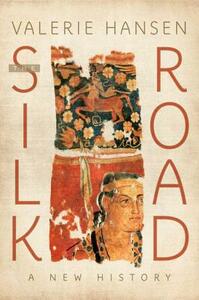Take a photo of a barcode or cover
informative
relaxing
slow-paced
challenging
informative
informative
slow-paced
informative
slow-paced
Given this book focuses on archeological study results, I didn't know expect it to hold my interest. I was pleasantly surprised. The findings in this book hold weight today in debates over the Uighurs' autonomy and with China's One Belt One Road initiative. Three stars because I don't think audiences outside of people with interest in History, China, and/or Central Asia would find this interesting. However, it was more compelling than I expected.
Valerie Hansen's The Silk Road: A New History brings together both archaeological and textual analyses to reassess the history of the famous trading route during the first millennium CE. Hansen focuses primarily on a cluster of oasis towns that are today located in far northwestern China or in Uzbekistan, places where the arid climate and the relative remoteness has helped to preserve the sites and their associated sources particularly well. She argues that despite the romance which has been associated with the Silk Road since the late nineteenth century, and popular ideas about its importance, that the overland routes were actually comparatively little travelled and weren't that economically important. The Silk Road's real historical value lies in how its network of interconnected local and regional trade circuits functioned as a conduit for languages, religions, and cultures.
I can't speak to the specifics of Hansen's arguments about the individual oasis societies, not being particularly familiar with them, but on a macro level her point seemed broadly persuasive. I just wish she'd settled on a different structure. This is a somewhat meandering book, and it wasn't always clear to me how individual parts added to the whole. It did, however, reinforce my desire to someday travel along at least part of the Silk Road myself.
I can't speak to the specifics of Hansen's arguments about the individual oasis societies, not being particularly familiar with them, but on a macro level her point seemed broadly persuasive. I just wish she'd settled on a different structure. This is a somewhat meandering book, and it wasn't always clear to me how individual parts added to the whole. It did, however, reinforce my desire to someday travel along at least part of the Silk Road myself.
Did you know the first printed book was not the Guttenberg Bible, but a Buddhist text, the Diamond Sutra? And without the Chinese invention of paper, the printing press would not have allowed for mass scale reproduction of texts. Paper allows ink to adhere and absorb, unlike vellum or other documents used for recording written words and transactions. The Diamond Sutra was found in a library cave along the Silk Road, along with many other important historical documents (that were then stolen and smuggled out of the country by Aurel Stein, a researcher working on behalf of the Indian and British authorities in the early 1900s). An excellent read on the history of the Silk Road that clarifies and corrects previously Western-based (and biased) histories. The author is able to write in a manner that non-academics can follow. I look forward to reading other histories by Valerie Hansen.
v good. had some interesting points regarding the image of the silk road, but it won't be very comprehensive if you haven't already divulged into the topic. i mostly ignored these instances and just relished in the reiteration of the histories of the oases town on the Silk Road. It could definitely serve as a neat introduction into the topic, even if the thesis tries to dispute an already established consensus. 4 out of 5 stars.
informative
slow-paced
A short but very detailed overview of the major oases and kingdoms that made up the legendary Silk Road, a network of trade routes that stretched from Iraq and Persia to western China, India to Mongolia and the Caucasus. It was most active from the 400s to the 900s, and goods of ever variety were transported back and forth, including textiles, metalworks, gemstones, grains, spices, and livestock. More importantly, however, it was vital to the exchange of art, religion, and scientific techniques between East and West; several distinct art styles arose due to the meeting of Chinese, Indian, Persian, and Hellenic artistic forms, and a variety of languages and writing styles developed as peoples from dozens of different places met and mingled. The author focused more on the linguistic history of the region, rather than the art, but as a student of languages, I found it fascinating. I also added about a dozen places to my list of future travel destinations after reading this book, which was a bonus. If you're interested in Central Asian art and history, this is a good, scholarly introduction to the subject.






